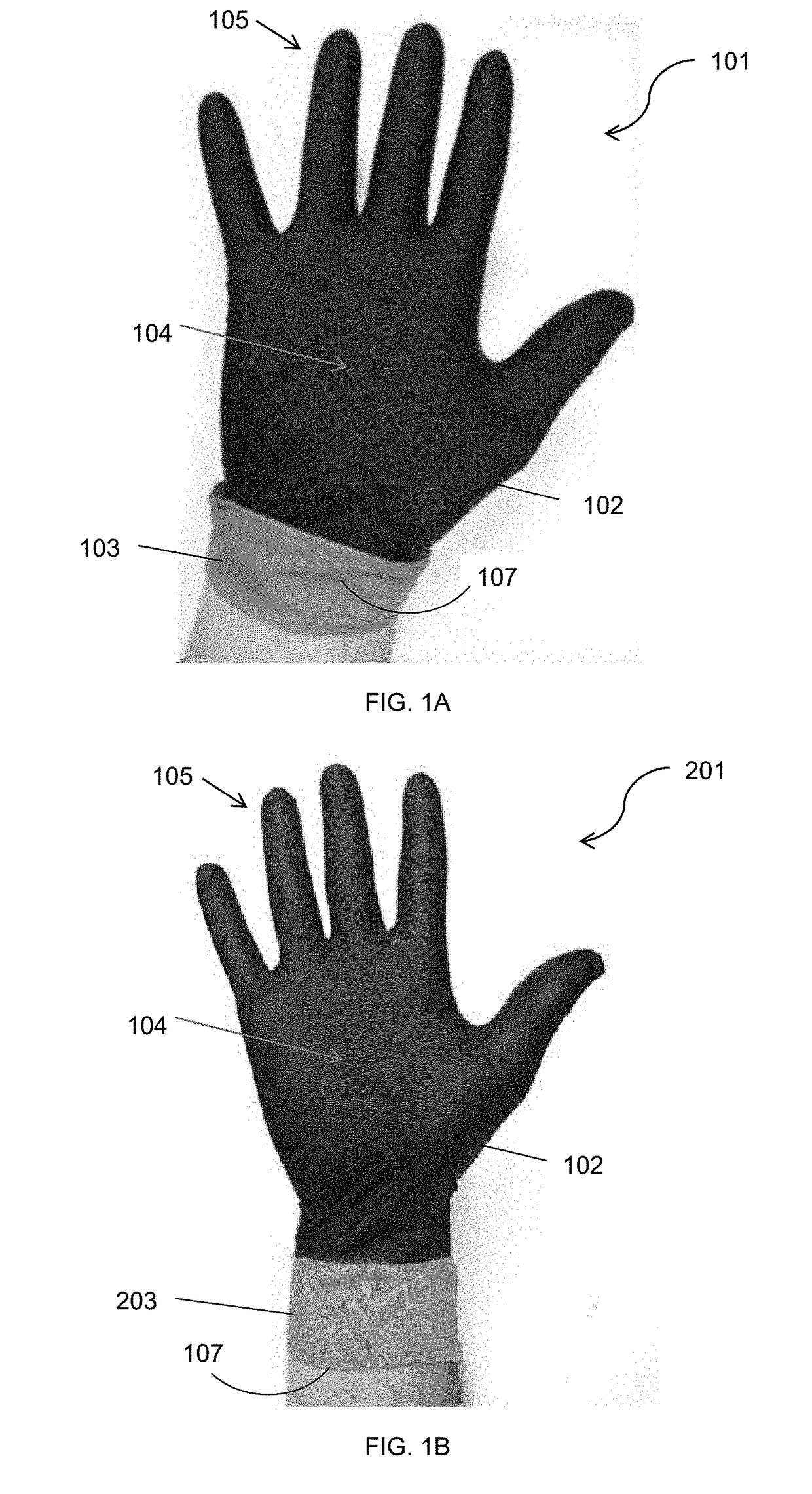Breach Detection Glove with a High Contrast Between the Color on the Donning Side and the Grip Side of the Glove
- Summary
- Abstract
- Description
- Claims
- Application Information
AI Technical Summary
Benefits of technology
Problems solved by technology
Method used
Image
Examples
example 1
[0114]In Example 1, elastomeric gloves were made using a polyurethane formulation and a nitrile rubber formulation via the 4-step coagulant dip-coating process described above and then subjected to mechanical testing. The polyurethane and nitrile rubber formulations utilized are described in more detail in Tables 2 and 3 below. The first coagulant dip (the dip step prior to the polyurethane dip) included 12 wt. % calcium nitrate, while the second coagulant dip (the dip step after the polyurethane dip and before the nitrile rubber dip) included 18 wt. % calcium nitrate. Gloves were formed so that the nitrile rubber layer extended past the polyurethane layer to form a cuff, and their mechanical properties were compared to conventional purple nitrile gloves. The tensile testing parameters and methods are defined in American Society for Testing and Materials (ASTM) test standard D-412-98a. In the present invention, the ASTM protocol was employed with no changes. The testing apparatus us...
example 2
[0116]In Example 2, the ability to form a multilayered glove from a four-dip process having a black pigment grip side layer and an orange pigment donning side layer was demonstrated. A glove mold was first dipped in a first powder free coagulant containing 10 wt. % calcium nitrate. The mold was then dipped in a first nitrile rubber formulation containing 1 part of black pigment per 100 parts of nitrile rubber to form the grip side layer, where the grip side layer had a total solids content of 20%. Then, the mold was dipped in a second powder free coagulant containing 18 wt. % calcium nitrate. Thereafter, the mold was dipped in a second nitrile rubber formulation containing 10 parts titanium dioxide and 5 parts orange pigment per 100 parts of nitrile rubber to form the donning side layer, where the layer had a total solids content of 20%. The mold was dipped to the same level for both nitrile rubber formulations, then the cuff region of the glove was folded over after its removal fro...
example 3
[0117]In Example 3, the ability to form a multilayered glove from a three-dip process having a black pigment grip side layer and an orange pigment donning side layer was demonstrated. A glove mold was first dipped in a first powder free coagulant containing 18 wt. % calcium nitrate. The mold was then dipped in a first nitrile rubber formulation containing 1 part of black pigment per 100 parts of nitrile rubber to form the grip side layer, where the grip side layer had a total solids content of 20%. Thereafter, the mold was dipped in a second nitrile rubber formulation containing 10 parts titanium dioxide and 5 parts orange pigment per 100 parts of nitrile rubber to form the donning side layer, where the layer had a total solids content of 20%. The mold was dipped to the same level for both nitrile rubber formulations, then the cuff region of the glove was folded over after its removal from the mold to expose the lighter donning side layer at the cuff. Due at least in part to the lig...
PUM
| Property | Measurement | Unit |
|---|---|---|
| Fraction | aaaaa | aaaaa |
| Fraction | aaaaa | aaaaa |
| Fraction | aaaaa | aaaaa |
Abstract
Description
Claims
Application Information
 Login to View More
Login to View More - R&D
- Intellectual Property
- Life Sciences
- Materials
- Tech Scout
- Unparalleled Data Quality
- Higher Quality Content
- 60% Fewer Hallucinations
Browse by: Latest US Patents, China's latest patents, Technical Efficacy Thesaurus, Application Domain, Technology Topic, Popular Technical Reports.
© 2025 PatSnap. All rights reserved.Legal|Privacy policy|Modern Slavery Act Transparency Statement|Sitemap|About US| Contact US: help@patsnap.com



